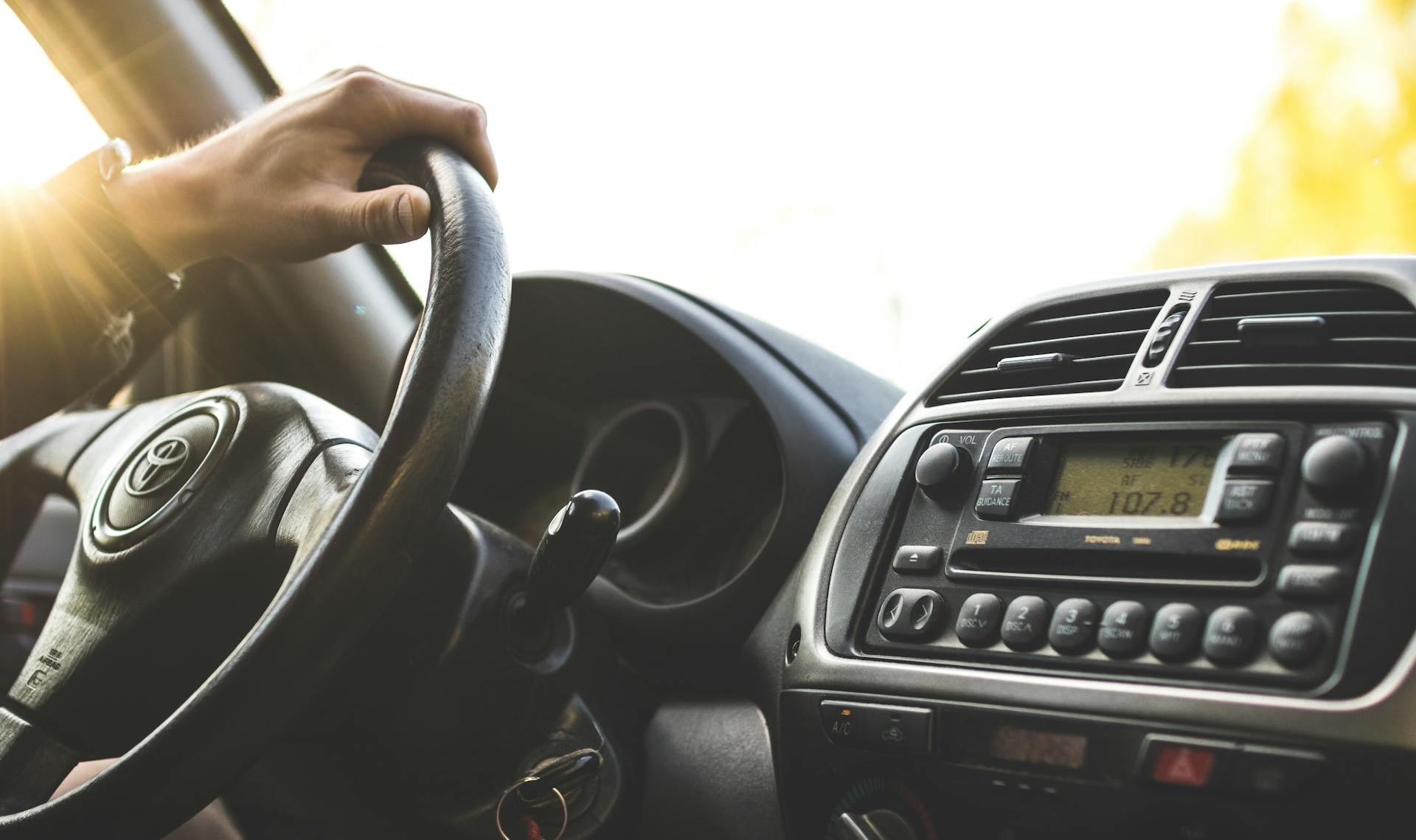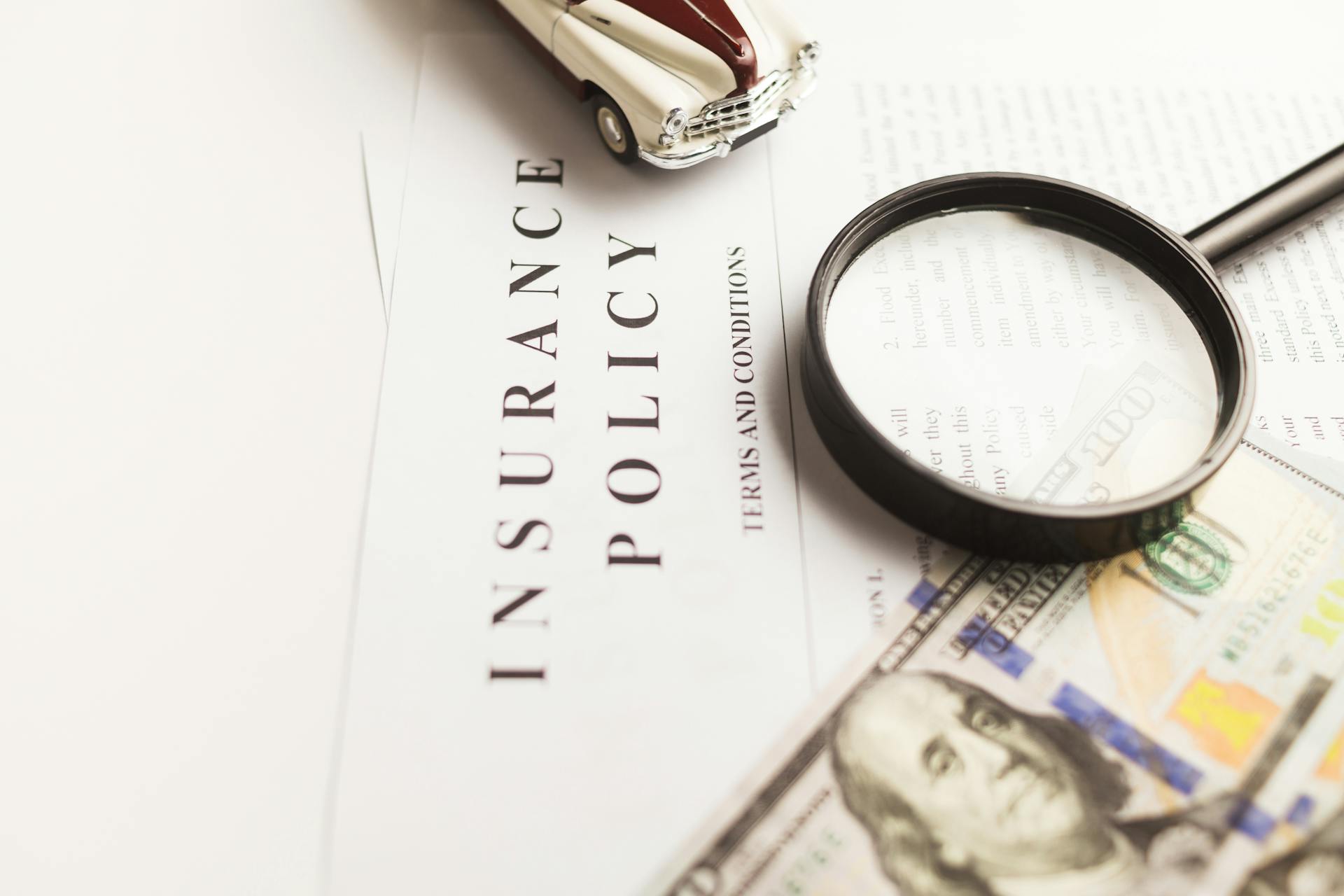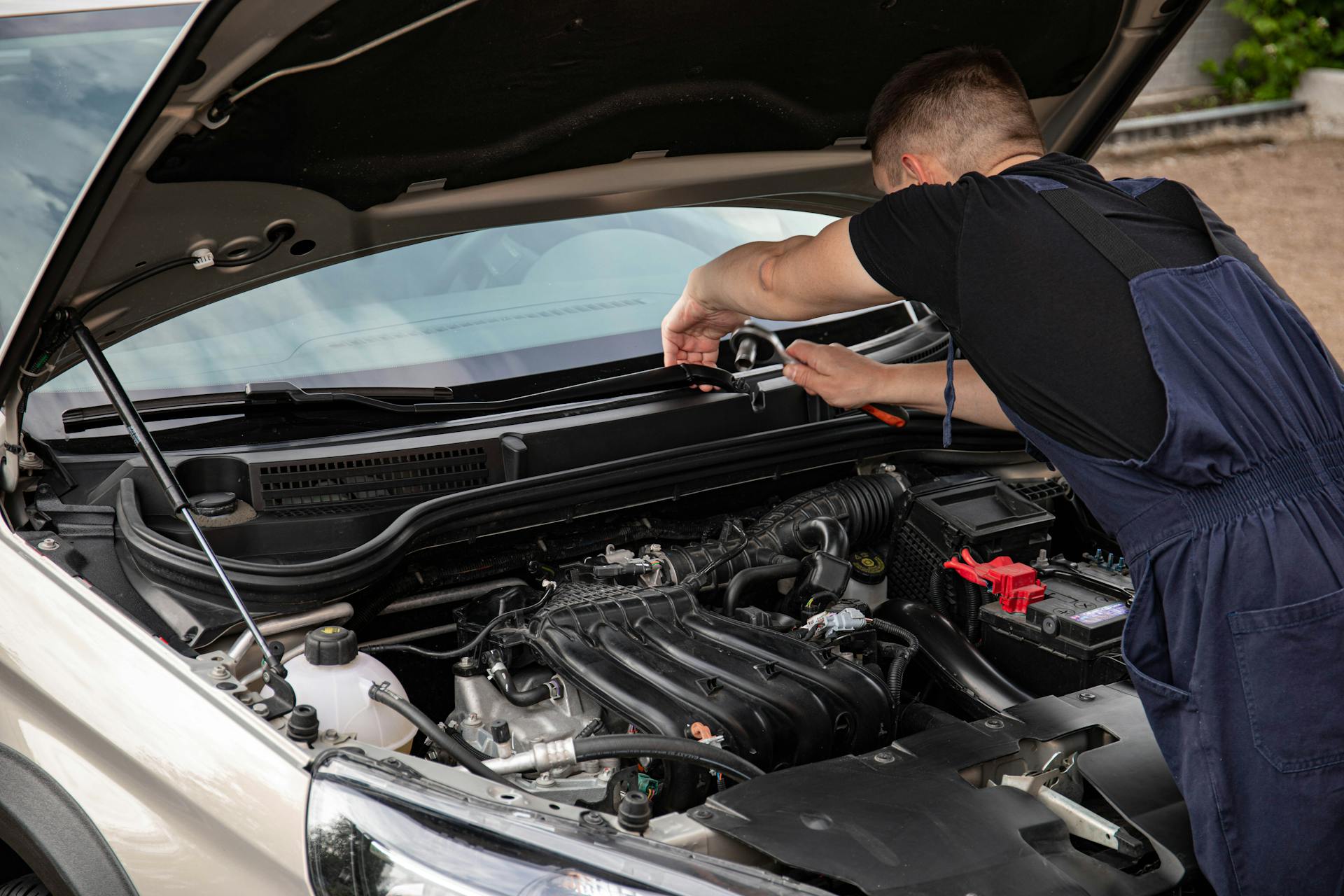
Car insurance can be a lifesaver in case your vehicle is stolen, but what about the items inside? According to our research, some car insurance policies may cover stolen items, but it depends on the policy and the value of the items.
Typically, comprehensive coverage includes stolen items, but the policy may have a limit on the amount that can be claimed. For example, if your policy has a $1,000 limit for stolen items, you may only be able to claim up to that amount, even if the items are worth more.
If you need to rent a car while your vehicle is being repaired or replaced, you may be able to claim the rental costs on your insurance policy. However, the policy may require you to have a certain level of coverage, such as collision or comprehensive coverage, to be eligible for rental car coverage.
Vandalism can also be covered under comprehensive coverage, but it's essential to document the damage and report it to the police to support your claim.
Discover more: Stolen Car Insurance Claim Investigation
Comprehensive Coverage
Comprehensive coverage is the type of auto insurance that covers theft or vandalism of your vehicle. It will protect you if your car is stolen or damaged in the process of being broken into.
Comprehensive coverage includes protection against non-collision-related incidents, such as theft, vandalism, fire, natural disasters, and collisions with animals.
Examples of damage that may be covered include a broken window, a damaged door lock, or stolen keys and other car parts.
Comprehensive coverage will typically help pay to replace your stolen vehicle if the perpetrator is not found, but you'll be responsible for paying the deductible.
Here are some examples of what comprehensive coverage can cover:
- A missing or stolen car
- Broken window from an attempted break-in
- Slashed tires
- A thief stealing your vehicle and then crashing it
- A thief stealing a permanent component of your car, e.g. a built-in stereo or steering wheel
- Catalytic converter theft
- A broken windshield
- Damage from hitting an animal or an animal hitting you
- Stolen or damaged keys and fob
- Fire damage
- Damage from falling or flying objects e.g. tree branches
- Damage from explosions
- Damage from riots and civil disturbances
- Damage from natural disasters and other weather-related events
Comprehensive coverage will also cover the theft of parts of your car, such as hubcaps, mirrors, or a catalytic converter.
Stolen Items
Your car insurance will cover items stolen from your car if they are permanently installed, such as radios, TVs in the headrests, and navigation systems. However, if you have aftermarket items installed, like rims or a stereo, you may need to consider custom parts and equipment coverage.
Typically, your comprehensive coverage will cover stolen items, but not personal property left in your car, unless it's a permanent element of your vehicle. For example, if you leave your smartphone behind in your car and a burglar smashes your car window and steals your phone, your car insurance company would not reimburse you for the lost phone.
If you have a laptop or phone in your car and it gets stolen, it's not covered by your auto insurance, but by your renters or homeowners insurance instead. You'll need to file a police report and provide the insurance company with the case number when making a claim.
If parts of your car are stolen, such as hubcaps, mirrors, or a catalytic converter, you can file a claim with your insurance company. They will cover the cost of replacing the stolen parts, minus your comprehensive deductible.
Here's a list of what comprehensive coverage typically covers:
- A missing or stolen car
- Broken window from an attempted break-in
- Slashed tires
- A thief stealing your vehicle and then crashing it
- A thief stealing a permanent component of your car, e.g. a built-in stereo or steering wheel
- Catalytic converter theft
- A broken windshield
- Damage from hitting an animal or an animal hitting you
- Stolen or damaged keys and fob
- Fire damage
- Damage from falling or flying objects e.g. tree branches
- Damage from explosions
- Damage from riots and civil disturbances
- Damage from natural disasters and other weather-related events
Rental and Vandalism
Rental car reimbursement coverage can help financially if your car is stolen, compensating policyholders for the cost of renting a vehicle while the authorities search for their stolen vehicles.
Comprehensive insurance covers vandalism, including broken windows or other damage resulting from a theft. If your car is broken into, take pictures of the damage and don't move your vehicle until a police officer gives the OK.
Rental Coverage
Rental Coverage is an important aspect to consider when protecting your vehicle. Rental car reimbursement coverage can be a lifesaver if your car is stolen.
This type of optional coverage can compensate policyholders for the cost of renting a vehicle while the authorities search for their stolen vehicle.
Vandalism
Vandalism can be a frustrating and costly experience, especially when it involves your car. If your car is broken into, take pictures of the damage and call the police. Don't move your vehicle until a police officer gives the OK.
Comprehensive insurance covers vandalism, including broken windows or other damage resulting from a theft. This coverage also pays out if a thief takes a specific part of your car, such as your keys. However, it won't cover personal property inside your car.
You'll need renters or homeowners insurance coverage to pay for any belongings, minus your deductible. Here are some examples of damage that may be covered under comprehensive insurance:
- Broken window from an attempted break-in
- Slashed tires
- A thief stealing your vehicle and then crashing it
- A thief stealing a permanent component of your car, e.g. a built-in stereo or steering wheel
- Catalytic converter theft
- A broken windshield
- Damage from hitting an animal or an animal hitting you
- Stolen or damaged keys and fob
- Fire damage
- Damage from falling or flying objects e.g. tree branches
- Damage from explosions
- Damage from riots and civil disturbances
- Damage from natural disasters and other weather-related events
If you've suffered vandalism, be sure to file a claim with your insurance company, providing details of the damage and the items that were taken.
Filing a Claim
Contact your insurance company immediately after a theft, even if it's just to notify them. This will help ensure a smooth claims process.
You'll need to provide a police report, which will ask for basic information about your car, such as the make and model, and its vehicle identification number.
Be prepared to answer questions about the theft, including where your car was stolen, when you think the theft happened, and any other details leading up to the theft.
You'll also need to have your insurance information on-hand, including your policy number, car's license plate number, and the name and contact information of the officer who responded to the scene of the theft.
If you're not certain about your policy or deductible, now is the time to ask. You should also ask if you'll be able to get a rental car while you look for a new permanent vehicle.
If your car was a lease or you were still paying off a loan, be sure to inform your lienholder or leasing company throughout the claims process.
Here are the key steps to follow when filing a claim:
- Contact the authorities to make a police report
- Be prepared to provide details about the theft
- Have your insurance information on-hand
- Ask important questions
- Keep up with your claim
Understanding Coverage
Comprehensive coverage is the only type of auto insurance that covers theft or vandalism of your vehicle. This type of coverage will protect you if your car is stolen or damaged in the process of being broken into.
Comprehensive coverage will cover damage to your vehicle, but it generally doesn't cover personal property left inside your car, unless it's a permanent element of your vehicle. For example, if you leave your smartphone behind and a burglar smashes your car window to steal it, your insurance company won't reimburse you for the lost phone.
Readers also liked: Does Comprehensive Insurance Cover Black Ice
Here are some examples of what comprehensive insurance covers:
- A missing or stolen car
- Broken window from an attempted break-in
- Slashed tires
- A thief stealing your vehicle and then crashing it
- A thief stealing a permanent component of your car, e.g. a built-in stereo or steering wheel
- Catalytic converter theft
- A broken windshield
- Damage from hitting an animal or an animal hitting you
- Stolen or damaged keys and fob
- Fire damage
- Damage from falling or flying objects e.g. tree branches
- Damage from explosions
- Damage from riots and civil disturbances
- Damage from natural disasters and other weather-related events
Keep in mind that the type of policy you have, the coverage you choose, and your insurance company will determine if your car insurance will cover items stolen from your car.
How It Works
Here's how your car insurance works after a theft.
Your comprehensive insurance covers you up to the actual cash value (ACV) of your car, which takes into account depreciation over time and the car's condition when it was stolen. This means your payout will be less than what you originally paid for your car.
If someone steals your car, you'll need to file a claim, providing details of the theft and the car's value. Your insurance will cover the value of your stolen car, minus your comprehensive deductible.
If you have items stolen from your car, your insurance will cover permanently installed items, such as radios, TVs in the headrests, navigation systems, custom wheels, vehicle batteries, and catalytic converters. These items are usually covered under comprehensive coverage.
For more insights, see: 2024 Kentucky Auto Insurance Comprehensive and Collision Coverage
If you have aftermarket items installed in your car, like rims or a stereo, you may want to consider custom parts and equipment coverage. This type of coverage is optional, but it can provide additional protection for your valuable items.
If you don't have custom parts and equipment coverage, your home or renters insurance policy may cover personal items stolen from your vehicle, subject to that policy's deductible. Some insurance companies, like Erie, offer personal items coverage, which pays up to $350 for personal items stolen from the vehicle.
Here's a quick rundown of what's covered in a typical comprehensive claim:
- Permanently installed items, such as radios and TVs, are usually covered under comprehensive coverage.
- Aftermarket items, like custom wheels and rims, may require custom parts and equipment coverage.
- Personal items, like clothes and electronics, may be covered under personal items coverage or your home or renters insurance policy.
In most cases, your insurance company will cover the cost of replacing stolen parts, minus your comprehensive deductible. This means you'll need to pay out of pocket for the deductible amount before your insurance kicks in.
For another approach, see: Does Gap Insurance Cover the Deductible
Types of Covers
Comprehensive coverage is the type of car insurance that covers theft, vandalism, and damage to your vehicle from non-collision-related incidents.

This type of coverage will protect you if your car is stolen or damaged in the process of being broken into, covering things like broken windows, damaged door locks, and stolen keys and other car parts.
Comprehensive insurance covers a wide range of incidents, including a missing or stolen car, broken windows, slashed tires, and damage from hitting an animal or an animal hitting you.
It also covers theft of permanent components of your car, such as a built-in stereo or steering wheel, and damage from natural disasters and other weather-related events.
If you have aftermarket items installed in your car, like custom wheels or a stereo, you may want to consider custom parts and equipment coverage, which can be added to your policy.
Comprehensive coverage typically does not cover the theft of personal property left in your car, unless it's a permanent element of your vehicle.
Here are some examples of what comprehensive insurance covers:
- A missing or stolen car
- Broken window from an attempted break-in
- Slashed tires
- A thief stealing your vehicle and then crashing it
- A thief stealing a permanent component of your car, e.g. a built-in stereo or steering wheel
- Catalytic converter theft
- A broken windshield
- Damage from hitting an animal or an animal hitting you
- Stolen or damaged keys and fob
- Fire damage
- Damage from falling or flying objects e.g. tree branches
- Damage from explosions
- Damage from riots and civil disturbances
- Damage from natural disasters and other weather-related events
Note that liability insurance, which is the most basic form of coverage, does not cover car theft or any damage to your own car.
Get Covered?
If your car is stolen, comprehensive insurance can help you financially. Comprehensive coverage can cover a wide range of scenarios, including a missing or stolen car, broken windows, and even damage from natural disasters.
A standard comprehensive policy typically covers permanently installed items like radios, TVs in the headrests, and navigation systems if they're stolen from your car.
Some insurance companies offer additional coverage for custom parts and equipment, like custom wheels or a stereo, but you'll need to provide receipts and details to the company.
If you have aftermarket items installed in your car, like custom rims or a paint job, you may want to consider custom parts and equipment coverage.
If someone damages your vehicle while breaking into it, like busting out a window to get to your personal items, damage to your vehicle would still be covered by comprehensive coverage in most scenarios.
If parts of your car are stolen, you can file a claim with your insurance company, providing details of the theft and the items that were taken. The insurance company will typically cover the cost of replacing the stolen parts, minus your comprehensive deductible.
A unique perspective: Which Insurance Companies Cover Oem Parts
Here's a breakdown of what comprehensive insurance typically covers:
- A missing or stolen car
- Broken windows from an attempted break-in
- Slashed tires
- A thief stealing your vehicle and then crashing it
- A thief stealing a permanent component of your car, e.g. a built-in stereo or steering wheel
- Catalytic converter theft
- A broken windshield
- Damage from hitting an animal or an animal hitting you
- Stolen or damaged keys and fob
- Fire damage
- Damage from falling or flying objects e.g. tree branches
- Damage from explosions
- Damage from riots and civil disturbances
- Damage from natural disasters and other weather-related events
Rental car reimbursement coverage may also be an option to help you financially if your car is stolen. This type of coverage can compensate policyholders for the cost of renting a vehicle while the authorities search for their stolen vehicle.
Frequently Asked Questions
What to do when someone steals stuff from your car?
Report the theft to the police and your insurance company, and document the stolen or damaged items to initiate the claims process
Can you file an insurance claim for stolen cash?
Insurance claims for stolen cash may be limited to a sublimit, which is a maximum amount you can recover. Check your policy wording to see if you're eligible for a claim
Sources
- https://www.brokerlink.ca/blog/does-car-insurance-cover-stolen-items
- https://www.bankrate.com/insurance/car/does-car-insurance-cover-theft/
- https://www.nerdwallet.com/article/insurance/cost-of-car-theft-insurance
- https://www.policygenius.com/auto-insurance/does-car-insurance-cover-theft/
- https://www.lemonade.com/car/explained/does-car-insurance-cover-theft/
Featured Images: pexels.com


